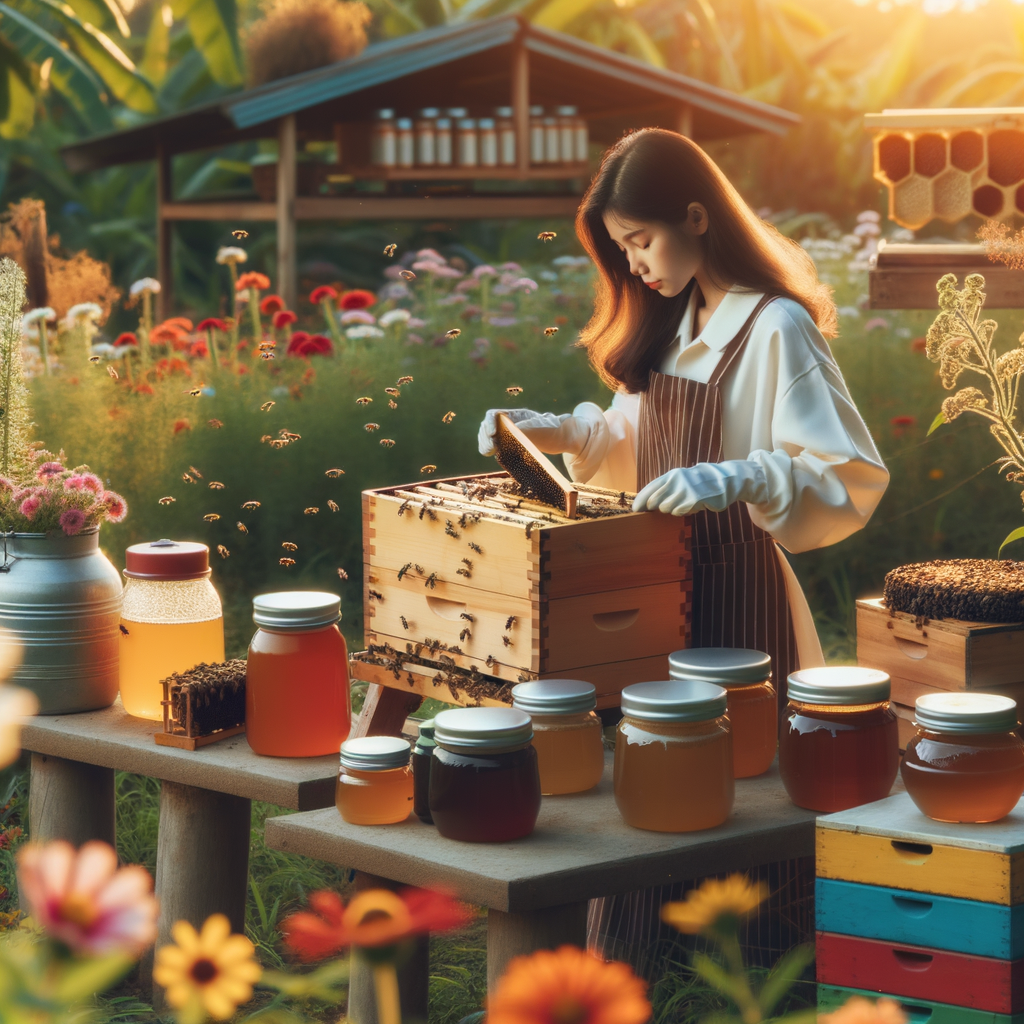
Introduction to Modern Beekeeping Practices
As we delve into the fascinating world of beekeeping, it’s important to understand how modern practices have revolutionized this age-old profession. The rise of modern beekeeping methods and the importance of keeping up with beekeeping updates have significantly impacted the industry, leading to more efficient and sustainable practices.
- The rise of modern beekeeping methods
Modern beekeeping practices have evolved significantly over the years. In the past, beekeepers used simple tools and techniques, often resulting in a low honey yield and a high mortality rate among bees. However, with the advent of new technologies and methods, beekeepers can now manage their hives more efficiently, leading to increased honey production and healthier bee colonies.
For instance, the introduction of the Langstroth hive in the 19th century revolutionized beekeeping. This hive design allows beekeepers to inspect and manage their colonies without disturbing the bees, leading to healthier hives and increased honey production. Other modern methods, such as the use of bee suits and smokers, have also made beekeeping safer and more efficient.
- Importance of keeping up with beekeeping updates
As with any profession, staying updated with the latest trends and practices in beekeeping is crucial. This not only helps beekeepers improve their methods and increase their yield, but also ensures the health and longevity of their bee colonies.
For example, recent studies have shown that certain pesticides can harm bees, leading to a decline in their population. By staying updated with this information, beekeepers can avoid using harmful substances and adopt more bee-friendly practices. Similarly, new research on bee diseases and pests can help beekeepers protect their colonies and prevent losses.
In conclusion, modern beekeeping practices have transformed the industry, making it more efficient and sustainable. By staying updated with the latest trends and practices, beekeepers can ensure the health and productivity of their colonies, contributing to a brighter future for our planet’s pollinators.
Latest in Beekeeping: Industry Trends
The world of beekeeping is always buzzing with new trends and techniques. Let’s dive into some of the latest industry trends that are shaping the way we interact with these incredible insects.
Current Beekeeping Techniques
There are several techniques currently being employed by beekeepers worldwide. We will focus on two of the most popular ones:
- Technique 1: The Langstroth Hive Method
- Technique 2: The Top-Bar Hive Method
The Langstroth Hive method is a classic technique that has been around since the 19th century. It involves the use of rectangular frames within a larger box to house the bees. The frames provide a structured space for bees to build their honeycombs. This method is popular due to its simplicity and effectiveness. Beekeepers can easily remove the frames to harvest honey without disturbing the bees or damaging the hive.
The Top-Bar Hive method is a more modern approach to beekeeping. Instead of using frames, this method uses bars placed across the top of the hive box. Bees build their honeycomb from these bars, hanging down naturally. This technique is gaining popularity because it’s more natural for the bees and requires less heavy lifting for the beekeeper. However, it can be more challenging to harvest honey without damaging the honeycomb.
Both techniques have their pros and cons, and the choice often depends on the beekeeper’s personal preference, resources, and the specific needs of their bees.
Stay tuned for more updates on the latest trends and techniques in the beekeeping industry. Remember, a good beekeeper is always learning and adapting to ensure the health and productivity of their hives.
Latest Beekeeping News
- Beekeepers Embrace Technology: In an exciting development, beekeepers are now using technology to improve their practices. A new app, called BeeApp, has been launched. This app helps beekeepers monitor their hives. It sends alerts if there are any changes in the hive. This means beekeepers can take quick action to protect their bees. Isn’t that amazing? Technology is not just for humans, but for bees too!
- Record Honey Production: Good news for honey lovers! The National Beekeepers Association has reported a record honey production this year. The increase is due to the hard work of beekeepers and the favorable weather conditions. This means more delicious honey for us to enjoy. So, next time you have honey, remember to thank the bees and the beekeepers!
These are just a few of the latest news in the world of beekeeping. The industry is buzzing with activity and innovation. Stay tuned for more updates and remember, every time you enjoy honey, you’re supporting the hard work of beekeepers and their bees.
Advances in Beekeeping: Equipment Updates
As the world of beekeeping evolves, so does the equipment used by beekeepers. Let’s explore some of the latest advancements in beekeeping equipment that are making the job easier, more efficient, and more productive.
Modern Beekeeping Equipment
Modern beekeeping equipment has been designed to make the process of beekeeping more streamlined and less labor-intensive. Here are two significant advancements:
- Automated Honey Extractors
- Smart Beehive Monitors
Automated honey extractors have revolutionized the way beekeepers harvest honey. These machines use centrifugal force to extract honey from the combs without damaging them. This means beekeepers can harvest more honey in less time, and the bees can reuse the combs, saving them energy and resources.
Smart beehive monitors are a game-changer in beekeeping. These devices use sensors to monitor the health and activity of the hive. They can track temperature, humidity, and even the weight of the hive to estimate honey production. The data is sent to the beekeeper’s smartphone, allowing them to keep a close eye on their bees without disturbing them.
These advancements in beekeeping equipment are not only making the job of the beekeeper easier but also helping to improve the health and productivity of the bees. As technology continues to evolve, we can expect to see even more exciting updates in the world of beekeeping.
How to Maintain Your Beekeeping Equipment
Keeping your beekeeping equipment in top shape is crucial for the health of your bees and the quality of your honey. Here are a couple of essential maintenance tips to help you keep your equipment in excellent condition.
- Maintenance Tip 1: Regular Cleaning
- Maintenance Tip 2: Regular Inspection
One of the most important aspects of maintaining your beekeeping equipment is regular cleaning. This includes all parts of your equipment, from the hive frames to the bee suits and smokers. Regular cleaning helps prevent the build-up of harmful bacteria and diseases that could affect your bees. It’s best to clean your equipment with warm, soapy water and let it dry completely before using it again.
Another key maintenance tip is to inspect your equipment regularly. Look for any signs of wear and tear, such as cracks or holes in your hive boxes, or fraying in your bee suits. If you spot any damage, it’s important to repair or replace the equipment as soon as possible to prevent any harm to your bees. Regular inspections can help you catch any potential issues early and keep your beekeeping operations running smoothly.
Remember, well-maintained beekeeping equipment not only ensures the health and productivity of your bees but also extends the lifespan of your equipment, saving you money in the long run.
Beekeeping Best Practices
In the world of beekeeping, there are certain practices that have proven to be more effective than others. These best practices are not just about producing more honey, but also about ensuring the health and well-being of your bees. Let’s delve into some essential tips that can help you become a successful beekeeper.
Essential Beekeeping Tips
Here are some tried and tested tips that can guide you on your beekeeping journey:
- Tip 1: Understand Your Bees
The first step towards successful beekeeping is understanding your bees. Bees are complex creatures with unique behaviors and needs. Spend time observing your bees and learning about their habits. This will help you provide them with the right conditions for their survival and productivity. - Tip 2: Choose the Right Equipment
The right equipment is crucial in beekeeping. This includes a good quality hive, protective gear, and tools for hive inspection and honey extraction. Investing in high-quality equipment can make your beekeeping tasks easier and safer.
Remember, beekeeping is a learning process. The more you learn about your bees and their needs, the more successful you will be in your beekeeping endeavors.
Case Study: Successful Beekeeping Practices
Let’s delve into a couple of real-life examples that demonstrate successful beekeeping practices. These case studies will provide a deeper understanding of how these practices are implemented and their impact on the beekeeping industry.
-
Case Study 1: The Honey Harvesters of New Zealand
In New Zealand, a group of beekeepers have been able to increase their honey production by 30% in just two years. How did they do it? They focused on implementing modern beekeeping practices, such as using advanced equipment and prioritizing bee health. They also invested in regular training for their beekeepers, ensuring they were up-to-date with the latest industry trends.
Key takeaway: Investing in modern equipment and continuous learning can significantly boost honey production.
-
Case Study 2: The Sustainable Beekeepers of Sweden
In Sweden, a cooperative of beekeepers has been making waves with their sustainable beekeeping practices. They’ve adopted a holistic approach, focusing not just on honey production but also on the health of the bee population and the environment. They’ve seen a decrease in bee mortality rates and an increase in honey quality, proving that sustainable practices can lead to success.
Key takeaway: Sustainable beekeeping practices can lead to healthier bees and higher quality honey.
These case studies highlight the importance of adopting modern and sustainable beekeeping practices. By learning from these successful examples, we can continue to improve and innovate in the field of beekeeping.
Conclusion: The Future of Beekeeping
As we look towards the future of beekeeping, it’s clear that this ancient practice is evolving in exciting ways. Modern technology, innovative equipment, and new industry trends are shaping a promising future for beekeepers around the world. However, the future of beekeeping isn’t just about the beekeepers; it’s also about the bees. As we continue to learn more about these fascinating creatures, we can develop better practices to ensure their survival and prosperity.
| Aspect | Future Outlook |
|---|---|
| Technology | Advancements in technology will continue to make beekeeping more efficient and less labor-intensive. |
| Industry Trends | There will be a continued focus on sustainable and ethical beekeeping practices. |
| Equipment | New equipment designs will make it easier to maintain healthy and productive hives. |
| Bee Health | Increased research and understanding will lead to better practices for maintaining bee health and combating threats like colony collapse disorder. |
Now, let’s summarize the key takeaways from our discussion on the future of beekeeping.
- Key takeaway 1: The future of beekeeping is bright, with advancements in technology, equipment, and industry trends paving the way for more efficient and sustainable practices.
- Key takeaway 2: The health and well-being of the bees remain paramount. As we move forward, it’s crucial that we continue to prioritize the health of our bees, using our growing knowledge and understanding to protect them from threats and ensure their survival.
As we step into the future, let’s remember that beekeeping is not just a profession or a hobby – it’s a responsibility. By taking care of our bees, we’re not just producing honey or beeswax – we’re playing a vital role in our ecosystem. Here’s to a future where both bees and beekeepers thrive.








